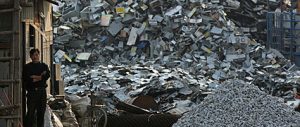Gong Jing’s article on cadmium-contaminated rice – which reflects the seriousness of China’s food-safety crisis – was originally published in Caixin’s flagship magazine, Century Weekly, on February 14, 2011. We translated it and reposted it on chinadialogue in three parts last April.
This week, the report won the “biggest impact” category at the 2012 China Environmental Press Awards, organised bychinadialogue, The Guardian and Sina, with the support of the SEE Foundation. In recognition of this achievement, we are republishing the first part of the article here.
Eighty-four year old Li Wenxiang pulled a small bag of rice out from under a paint-stained table. The grains were white, plump and slightly translucent – to the naked eye, no different from any other rice. But tests have shown the levels of cadmium in this rice far exceed permitted limits. The locals call it “cadmium rice”.
Cadmium is a heavy metal, listed in 48th place on the periodic table. In nature, it is found as a compound in ores, but in the human body, it can cause serious harm.
Li believes the rice may be the cause of the strange condition afflicting him. Although in good health otherwise, Li has not been able to walk properly for 20 years. He cannot manage 100 metres without feeling unbearable pains in his feet and calves.
Doctors have not been able to come up with a diagnosis, so Li just calls it “soft-foot disease”. He said that, here in the village of Side in Guangxi province, south China, more than a dozen elderly people suffer similar symptoms.
Li has been eating the local rice for 28 years, ever since he returned to the village for retirement in 1982. Research papers by a number of academics have shown that the village’s farmland was polluted by cadmium before even the 1960s and, as a result, levels of the substance in the rice grown here are far above those permitted by the state.
Cadmium is often found where zinc, lead and copper are mined. As a result of the heating and leaching processes these ores are subjected to, cadmium is released into the waste-water. If the mine is not properly managed, the water then carries the cadmium into the surrounding soil. Research by experts at the US Department of Agriculture shows that, of all major crops, rice is second only to lettuce in its ability to absorb cadmium.
Other research has indicated that cadmium accumulates in the liver and kidneys, and is not naturally expelled from the body. After years, or even decades, of gradual accumulation, the body will start to show signs of cadmium poisoning. Most commonly, this affects liver function and bone health – resulting in a range of skeletal changes.
In Japan in the 1960s, hundreds of people living in the Jinzu River basin in Toyama Prefecture were affected by skeletal pain. Mining had left local fields heavily polluted with cadmium and, after years eating rice grown on the land, farmers were suffering from cadmium poisoning. Those affected complained of stabbing pains in their bones, and the disease came to be known as “ouch-ouch sickness”. The symptoms are very similar to Li Wenxiang’s “soft-foot” condition, and researchers have pointed out that many other villagers in Side have health problems similar to those seen in the early stages of “ouch-ouch”.
Cadmium is not the only heavy metal found at high levels in rice in China. The country has struggled with a food-supply pollution chain for many years: China’s rapid industrialisation has resulted in widespread mining and heavy metals such as cadmium, arsenic and mercury, once locked in compounds underground, being released. Via water and the air, these have polluted a significant proportion of China’s land, from where they enter crops and, subsequently, human beings.
On a visit to Side in December 2010, villagers privately confirmed that a number of residents were suffering pains all over their body. One person who married into the village in the early 1980s said that, back then, girls from other villages didn’t want to marry men from Side as they were scared they would have “soft-boned” children. That turned out to be an exaggeration, but there are still concerns.
The villagers said that, before China’s grain markets were liberalised, state-owned granaries used to refuse their crops: “Your village’s rice is poisoned,” the officials told them. But the inhabitants of Side have no option but to eat this “poisoned” rice that the government would not accept.
In mid-winter, the fields were littered with the stalks left over from harvesting, while vegetables grew green and lush alongside. But appearances can be deceptive: the 1,000 mu (0.7 square kilometre) Dadong Field is in bad shape. Tests in 1986 found soil cadmium levels of up to 7.79 milligrams per kilogram – 26 times the permitted level.
A 1986 study by Lin Bingying, a professor at Guilin University of Technology, found that cadmium levels in young rice plants in the village were three times the acceptable limit, set by central government, of 0.2 milligrams per kilogram, while mature plants were five times over the limit, reaching 1.005 milligrams per kilogram.
An environmental-protection official with the local agricultural bureau said that, to date, there has been little improvement. One senior agricultural expert said that cadmium pollution is largely irreversible – once the soil is contaminated, levels of cadmium in crops will remain constant for years.
The water in the paddy fields comes from Side River, which was polluted by a zinc and lead mine 15 kilometres upstream. The mine is small and, when first established by the county in the 1950s, had no environmental-protection measures in place – cadmium-contaminated water was even used to irrigate the villagers’ fields. Over 5,000 mu (3.3 square kilometres) of farmland was contaminated by the mine, with Datong Field the worst affected. Subsequent research found that waste-water from the mine contained 194 times the level of cadmium permitted in water used for irrigation.
The mine isn’t very profitable and has been shut down for various periods over the decades. Currently, it is in private hands. None of the villagers know for sure if the “poison” from the rice has entered their bodies and, if it has, what will happen. The majority of them are unable to prove the pains they suffer are even due to an illness, much less any link with the rice.
In 2002, the quality monitoring centre for rice and rice products at China’s Ministry of Agriculture carried out safety checks on samples of rice available on the market nationwide. The results indicated that the most widespread problem was lead contamination, with 28.4% of samples breaching limits. Second was cadmium, at 10.3%.
Five years later, in 2007, Pan Genxing, professor at Nanjing Agricultural University’s Institute of Resources, Ecosystem and Environment of Agriculture, led a study which purchased 91 samples of rice from markets at the county level or higher in six regions across China. The results were similar – 10% of rice on the market had excessive levels of cadmium.
Their study was published in the journal Safety and Environment, but unfortunately even this did not attract much attention. Many academics have argued that, as there normally aren’t any restrictions on planting rice on polluted land, a figure of 10% of rice containing excessive cadmium is a realistic one for China today.
Rice is the staple food for 65% of China’s people, and the country produces almost 200 million tonnes of the crop each year – so 10% represents about 20 million tonnes. Pan Genxing’s research also indicates that heavy-metal pollution mainly affects the southern long-grained rice variety, with provinces such as Hunan and Jiangxi particularly badly hit. In April 2008, Pan’s team purchased 63 samples of rice from markets in provinces including Jiangxi, Hunan and Guangdong – and 60% were found to breach national standards for cadmium levels. One reason for this is that the hybrid rice used in southern acidic soils absorbs more than normal rice.
Chen Tongbin is a researcher at the Chinese Academy of Science’s Institute of Geographic Sciences and Natural Resources Research. For years he has studied soil pollution and restoration. According to Chen, heavy-metal pollution in northern China exists in scattered patches, but in the south the problem is more common, and in parts of Hunan, Jiangxi, Yunnan and Guangxi, affects wide swaths of land.
Chen disagrees with the common belief that one fifth of China’s arable land is polluted by heavy metals. He said a figure of one tenth is more likely, based on studies of wide areas of land in several provinces carried out over a number of years. Cadmium and arsenic pollution are the most common problem, he said, with each present in about 40% of polluted land.
If Chen’s estimate is accurate, 120,000 square kilometres of China’s total 1.2 million square kilometres of arable land is contaminated with pollutants like cadmium and arsenic. Around 54,000 square kilometres of land may be polluted with cadmium alone.
Most of these polluted areas are still growing rice, most farmers are still eating their own crops and rice contaminated with heavy metals is still reaching the market. There is nothing to protect the Chinese people from this threat.
This article first appeared in Century Weekly, where Gong Jing is a reporter.
NEXT: Tracing the sources of cadmium pollution
Part three: Fixing the problem
Homepage image from Greenpeace


